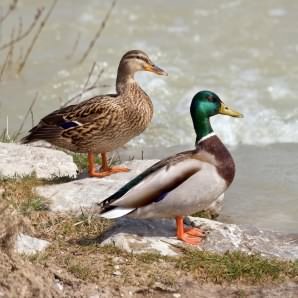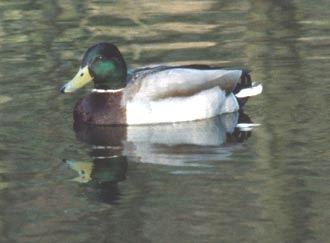
Photo ©2008 Richard Bartz

Photo ©2018–
Click any photo for a larger image

Picture ©2000 Wild Britain
Mallard - Anas platyrhynchos
Family - Anatidae
Widespread in the Americas, Europe, Asia, North Africa and introduced to Australia and an invasive in New Zealand, the Mallard is a very familiar gregarious dabbling duck found on most stretches of water, overgrown ponds, lakes, pools and slow flowing rivers. Growing to 45–65cm (17–25in) long with a wingspan of 80–100cm (31–39in), the male in breeding condition is a extremely colourful bird with a green iridescent head and orange yellow beak tipped black, white collar, brown breast tinged purple, black rear and white borders to the tail.
The female is an overall mottled brown but has an orange beak. Both have a blue and white patch on the trailing edge of each wing although these are shed and regrown during their annual moult. Average life expectancy for a Mallard is around 20 years. Male Mallards have a nasal call, and high–pitched whistle, while the female has a deeper "quack" typically associated with ducks. The Mallard is the root species of most of our domestic ducks.
Nests are usually built on the ground close to water, but occasionally in a tree, with a clutch of eight to fourteen grey–green eggs, incubated solely by the female in about three weeks. Young are capable of swimming very soon after hatching following the female to water, diving promptly if in danger.
The Mallard is an omnivorous feeder with a mixed diet of larvae, pupae, aquatic animals, plant material and seeds, however they are often fed large amounts of bread by the public and can become very tame. This is a popular misconception that ducks should be fed bread, but it has limited nutritional value for them and it can lead to the death of small ducklings. Any bread left behind in the water can lead to the water becoming polluted, causing algal blooms, allowing bacteria to breed and attracting rats. Ducks do not have "teeth", they have serrations (saw–like edges) on their bills that allow them to filter food out of the water. Mallards are predated by a range of species including raptors, mustelids, corvids, snakes, felids and canids, with the Red fox possibly the most prolific.
Article - why you shouldn't feed ducks bread.
 Photo ©2008 Richard Bartz |
 Photo ©2018– Click any photo for a larger image |
 Picture ©2000 Wild Britain |
Site design ©1999– Brickfields Country Park - Privacy -